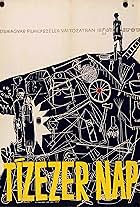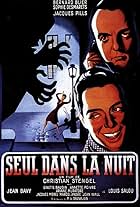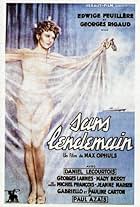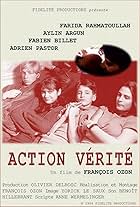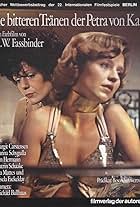IMDb RATING
6.3/10
2.6K
YOUR RATING
Peter Von Kant, a successful, famous director, lives with his assistant Karl, whom he likes to mistreat and humiliate. Through the great actress Sidonie, he meets and falls in love with Amir... Read allPeter Von Kant, a successful, famous director, lives with his assistant Karl, whom he likes to mistreat and humiliate. Through the great actress Sidonie, he meets and falls in love with Amir, a handsome young man of modest means.Peter Von Kant, a successful, famous director, lives with his assistant Karl, whom he likes to mistreat and humiliate. Through the great actress Sidonie, he meets and falls in love with Amir, a handsome young man of modest means.
- Awards
- 3 wins & 8 nominations
- Director
- Writers
- All cast & crew
- Production, box office & more at IMDbPro
Storyline
Did you know
- TriviaHanna Schygulla, who plays Peter's mother, originated the role of Karin Thimm, the object of desire in the Rainer Werner Fassbinder film The Bitter Tears of Petra von Kant (1972).
- Crazy creditsA photo of Rainer Werner Fassbinder is shown in the opening credits.
- ConnectionsFeatures The Bitter Tears of Petra von Kant (1972)
- SoundtracksJeder Tötet was er Liebt
Music by Peer Raben and David Ambach
Lyrics by Oscar Wilde
Performed by Isabelle Adjani
Featured review
"Peter Von Kant"
Peter Von Kant (Dennis Ménochet), a successful, famous director, lives with his assistant Karl (Stefan Crepon), whom he likes to mistreat and humiliate. Through the great actress Sidonie (Isabelle Adjani), he meets and falls in love with Amir (Khalil Ben Gharhia), a handsome young man of modest means. He offers to share his apartment and help Amir break into the world of cinema.
For Fassbinder, the world of fashion was merely a context. Petra's work is not developed or analyzed. We only know that she's successful, that she needs to draw new designs, and that her assistant is there to help her. His work is how he meets others, discovers them, elevates them. Amir reveals himself before the camera, not just to Peter but also to the viewer. Suddenly we see him differently, he becomes an actor, which also makes us doubt his sincerity. Is his story true, or is it merely calculated to move Peter, to stimulate his desire to create? When Peter seizes the camera, his appetite to film Amir is clear. That movement plunges him into the creative desire of Pygmalion for Galatea. Sidonie is also a variation on the theme of Pygmalion and his muse. Peter loves and hates her simultaneously. 'I preferred the actress to the woman', he says. In Fassbinder, the character is merely a confidante; a best friend for Petra to bounce of off. We imagine Peter as a big drama queen, always making too much of things. In the Fassbinder film there's a queer side, with the women overplaying their femininity. Peter is forever drowning in his emotions. He's excessive, overly emphatic. And more often than not, he's high on alcohol or drugs. The trick is to embrace the theatricality of the character. The color and stylization work characterizes his final period on material from his first period.
Peter wants to take Amir in, protect him, be his Pygmalion. Peter falls in love not just with Amir but also with the creature he could shape Amir into. And when Amir ultimately escapes him, Peter is riddled with jealousy. And again, all his theories about freedom in relationships come tumbling down. When Peter meets Amir, there's a sexual fantasy for sure, but he's also found someone who is as alone as he's, whose life is broken. Beyond the physical and sexual attraction. Peter ends up alone, but he has his memories of Amir on film. Exploring the theme of love through the prism of cinema is moving, especially right now, with changing attitudes towards going to the movies, falling theatre attendance, the emergence of platforms. This film "Peter von Kant" is perhaps more optimistic than Fassbinder's. Though Peter ends up alone and isolated, his eyes are open to his films, his imagination, fiction. He films Amir, he records his love. Creation and cinema save Peter.
The film is an adaptation of 'The Bitter Tears of Petra von Kant'. Fassbinder originally wrote the story for the theatre. He made it into a film in 1972 when he was just 25 years old. He had recently discovered the Hollywood melodramas of Douglas Sirk, and used all the theatrical and cinematic artifices and mannerisms at his disposal to film his play about emotional dependence and the impossibility of loving as equals. Fassbinder's body of work, philosophy and vision of the world have always haunted us. His unbelievable creative energy fascinates us. The film centers around one of Fassbinder's passionate love affairs. In 'The Bitter Tears of Petra von Kant', Fassbinder had turned his own unhappy love affair with one of his favorite actors, Günther Kaufmann, into a lesbian love story between a fashion designer and her model. The character of Karl is inspired by Peer Raben, who composed music for Fassbinder's films and was also his assistant. The film trades the world of fashion for the world of cinema and changes the gender of the three main characters. It's a way of betraying Fassbinder the better to find him, in a universal tale of passionate love. The story is more relevant than ever in the way it questions the power dynamics of domination in the creative arts, the Pygmalion/muse relationship.
'Water Drops on Burning Rocks' was consciously very theatrical, with an ironic detachment reminiscent of Fassbinder's cinema. This film wants to inject more empathy into a new version of 'The Bitter Tears of Petra von Kant'. Maybe with age and experience we understand Fassbinder better, the way he sees life, creation and love right down to it's most monstruous aspects. Fassbinder is not a loveable filmmaker. His films are not loveable. But we feel a wide range of emotions towards Peter. To hate him one minute and find him touching, grotesque or endearing the next. He blends the intimate and the political in the most naked of ways, both literally and figuratively. The effect is at once pathetic, sincere and devastating. There's also a dash of boulevard in Fassbinder's work, but it's more Brechtian, there's more distancing. The film wsnts to highlight the emotional power of the text, bring the character's humanity and feelings to the fore, leave behind Fassbinder's little theatre of puppets in favor of flesh and blood characters. The bitter tears in Fassbinder's play and film are artificial, which is what makes them beautiful, both theatrically and cerebrally.
Written by Gregory Mann.
Peter Von Kant (Dennis Ménochet), a successful, famous director, lives with his assistant Karl (Stefan Crepon), whom he likes to mistreat and humiliate. Through the great actress Sidonie (Isabelle Adjani), he meets and falls in love with Amir (Khalil Ben Gharhia), a handsome young man of modest means. He offers to share his apartment and help Amir break into the world of cinema.
For Fassbinder, the world of fashion was merely a context. Petra's work is not developed or analyzed. We only know that she's successful, that she needs to draw new designs, and that her assistant is there to help her. His work is how he meets others, discovers them, elevates them. Amir reveals himself before the camera, not just to Peter but also to the viewer. Suddenly we see him differently, he becomes an actor, which also makes us doubt his sincerity. Is his story true, or is it merely calculated to move Peter, to stimulate his desire to create? When Peter seizes the camera, his appetite to film Amir is clear. That movement plunges him into the creative desire of Pygmalion for Galatea. Sidonie is also a variation on the theme of Pygmalion and his muse. Peter loves and hates her simultaneously. 'I preferred the actress to the woman', he says. In Fassbinder, the character is merely a confidante; a best friend for Petra to bounce of off. We imagine Peter as a big drama queen, always making too much of things. In the Fassbinder film there's a queer side, with the women overplaying their femininity. Peter is forever drowning in his emotions. He's excessive, overly emphatic. And more often than not, he's high on alcohol or drugs. The trick is to embrace the theatricality of the character. The color and stylization work characterizes his final period on material from his first period.
Peter wants to take Amir in, protect him, be his Pygmalion. Peter falls in love not just with Amir but also with the creature he could shape Amir into. And when Amir ultimately escapes him, Peter is riddled with jealousy. And again, all his theories about freedom in relationships come tumbling down. When Peter meets Amir, there's a sexual fantasy for sure, but he's also found someone who is as alone as he's, whose life is broken. Beyond the physical and sexual attraction. Peter ends up alone, but he has his memories of Amir on film. Exploring the theme of love through the prism of cinema is moving, especially right now, with changing attitudes towards going to the movies, falling theatre attendance, the emergence of platforms. This film "Peter von Kant" is perhaps more optimistic than Fassbinder's. Though Peter ends up alone and isolated, his eyes are open to his films, his imagination, fiction. He films Amir, he records his love. Creation and cinema save Peter.
The film is an adaptation of 'The Bitter Tears of Petra von Kant'. Fassbinder originally wrote the story for the theatre. He made it into a film in 1972 when he was just 25 years old. He had recently discovered the Hollywood melodramas of Douglas Sirk, and used all the theatrical and cinematic artifices and mannerisms at his disposal to film his play about emotional dependence and the impossibility of loving as equals. Fassbinder's body of work, philosophy and vision of the world have always haunted us. His unbelievable creative energy fascinates us. The film centers around one of Fassbinder's passionate love affairs. In 'The Bitter Tears of Petra von Kant', Fassbinder had turned his own unhappy love affair with one of his favorite actors, Günther Kaufmann, into a lesbian love story between a fashion designer and her model. The character of Karl is inspired by Peer Raben, who composed music for Fassbinder's films and was also his assistant. The film trades the world of fashion for the world of cinema and changes the gender of the three main characters. It's a way of betraying Fassbinder the better to find him, in a universal tale of passionate love. The story is more relevant than ever in the way it questions the power dynamics of domination in the creative arts, the Pygmalion/muse relationship.
'Water Drops on Burning Rocks' was consciously very theatrical, with an ironic detachment reminiscent of Fassbinder's cinema. This film wants to inject more empathy into a new version of 'The Bitter Tears of Petra von Kant'. Maybe with age and experience we understand Fassbinder better, the way he sees life, creation and love right down to it's most monstruous aspects. Fassbinder is not a loveable filmmaker. His films are not loveable. But we feel a wide range of emotions towards Peter. To hate him one minute and find him touching, grotesque or endearing the next. He blends the intimate and the political in the most naked of ways, both literally and figuratively. The effect is at once pathetic, sincere and devastating. There's also a dash of boulevard in Fassbinder's work, but it's more Brechtian, there's more distancing. The film wsnts to highlight the emotional power of the text, bring the character's humanity and feelings to the fore, leave behind Fassbinder's little theatre of puppets in favor of flesh and blood characters. The bitter tears in Fassbinder's play and film are artificial, which is what makes them beautiful, both theatrically and cerebrally.
Written by Gregory Mann.
- gregorymannpress-74762
- Jul 2, 2022
- Permalink
- How long is Peter von Kant?Powered by Alexa
Details
Box office
- Gross worldwide
- $667,827
- Runtime1 hour 25 minutes
- Color
- Aspect ratio
- 2.35 : 1
Contribute to this page
Suggest an edit or add missing content















